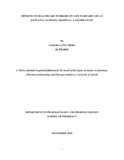| dc.contributor.author | Gakera, Lina N | |
| dc.date.accessioned | 2019-01-09T09:23:21Z | |
| dc.date.available | 2019-01-09T09:23:21Z | |
| dc.date.issued | 2018 | |
| dc.identifier.uri | http://hdl.handle.net/11295/104522 | |
| dc.description.abstract | Background: Warfarin is an anticoagulant used in treating patients with deep vein thrombosis to prevent the extension of the clot and to reduce the risk of developing pulmonary embolism. It is also used in patients with atrial fibrillation or artificial heart valves to reduce the risk of stroke. Despite all its benefits, it has a narrow therapeutic margin. It can cause major or fatal bleeding and treatment should be monitored regularly using the International normalized ratio (INR) test.
Study objectives: The objectives of the study were to: gather opinions of health care workers on risk assessment for patients receiving warfarin, collate opinions of health care workers on initial and subsequent maintenance dosing of warfarin, gather opinions of health care workers on monitoring of warfarin treatment and to collate opinions of health care workers on reversal of over-anticoagulation with warfarin.
Study design: A Delphi study comprising of three rounds was employed to determine the opinions of healthcare workers on safe warfarin use at Kenyatta National Hospital (KNH).
Study area: The study was carried out at Kenyatta National Hospital. The KNH cardiothoracic surgery clinic (number 24), haemato-oncology clinic (number 23) and medical clinic (number 17) which serve patients requiring specialized care on warfarin anticoagulation therapy.
Study participants: The Delphi panel comprised of 4 cardiologists, 4 physicians and 2 pharmacists who offer anticoagulation services to patients in KNH. These panelists met the inclusion criteria and gave informed consent.
Methods: Delphi panelists were sampled through purposive sampling and recruited from a list of KNH specialists (Cardiologists, physicians and clinical pharmacists) offering their expertise in the respective KNH clinics. The Delphi process involved three rounds of filling questionnaires where the subsequent questionnaire was formulated from the preceding questionnaire. The first round presented an open-ended questionnaire while the other two rounds involved closed ended questionnaires.
Data analysis: The qualitative data collected was entered into a password protected Microsoft word (2010) sheet while the quantitative data was entered into Microsoft Excel (2010) sheet. ATLAS.ti scientific software for qualitative data analysis was utilized. Quantitative data was analyzed using Stata® version 13 (Stata Corp, USA). Measures of central tendency (median and mean) were used to present information concerning demographics of panelists. Percentages were used to calculate the response rate of panelists and to present the judgements concerning the Delphi statements. Tables and charts were utilized to present the findings of the Delphi study.
Results: Patient education and counselling through face to face discussions about anticoagulation with warfarin was the most recommended way of alleviating risks associated with warfarin. CHA2DS2VASc score was the most preferred method of assessing a patient’s stroke risk factor while the HAEMORR2HAGES score was preferred for assessing the patient’s bleeding risk. A standardized dosing algorithm for warfarin was suggested. The initial dosage of warfarin was recommended at 5mg per oral once daily. Warfarin dose adjustments should be made based on total weekly doses rather than daily doses. Bridging with a LMWH should be administered for 5 days until therapeutic INR was reached. The most recommended LMWH in KNH was enoxaparin.
Baseline INR test, full haemogram test and a pregnancy test were the mandatory tests to be done before initiating warfarin therapy. An INR of between 2-3 was found to be ideal for most disease
conditions requiring warfarin anticoagulation. INR levels should be checked every 2-3 days after initiation of warfarin until it lies within therapeutic range. Diet variations, concurrent medications, comorbidities and non-adherence to warfarin anticoagulation were the highest influencers of INR. In the case of any presence of clinically significant bleeding where warfarin- induced coagulopathy was considered a contributing factor, warfarin should be stopped, IV vitamin K given, blood transfusion and fresh frozen plasma should be administered.
Conclusion: In this study, more than 70% consensus or higher was reached for most statements. We were able to develop a consensus statement on safe warfarin use by cardiologists, physicians and pharmacists using the Delphi method. | en_US |
| dc.language.iso | en | en_US |
| dc.publisher | University of Nairobi | en_US |
| dc.rights | Attribution-NonCommercial-NoDerivs 3.0 United States | * |
| dc.rights.uri | http://creativecommons.org/licenses/by-nc-nd/3.0/us/ | * |
| dc.title | Opinions of healthcare workers on safe warfarin use at Kenyatta National Hospital | en_US |
| dc.type | Thesis | en_US |
| dc.description.department | a
Department of Psychiatry, University of Nairobi, ; bDepartment of Mental Health, School of Medicine,
Moi University, Eldoret, Kenya | |



